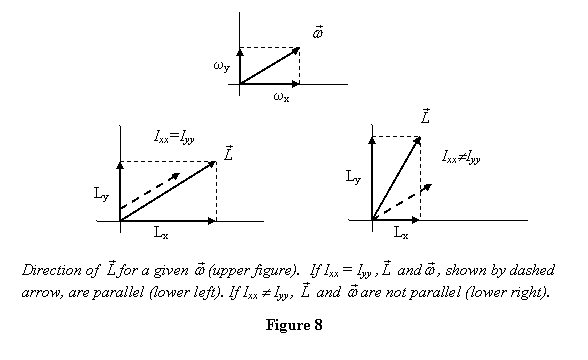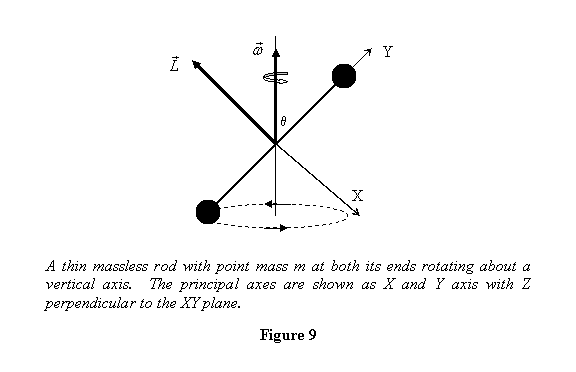Angular momentum of a rigid body rotating with angular velocity  : We
now derive the relationship between the angular momentum
of a body rotating in space with one point fixed. That means
the body is not translating and has only three degrees of
freedom. By definition, the angular momentum
: We
now derive the relationship between the angular momentum
of a body rotating in space with one point fixed. That means
the body is not translating and has only three degrees of
freedom. By definition, the angular momentum

For a rigid body rotating with one point fixed, I have
derived above that  .
With
.
With

we get

This gives the three components of the angular momentum
to be



This is usually written in the matrix form

The (3 x 3) matrix in the equation above is known
as the moment of inertia tensor. Its diagonal
terms

are the moments of inertia about the x , y and
the z -axis, respectively. The off-diagonal
terms

are known as the products of inertia. The values of the
moments and products of inertia depend on the set of
axes chosen.
So you see that relationship between  is
quite involved. Luckily, for a rigid body, for
each point one can find a set of axes about so that products
of inertia about that point vanish. These are known as
the principal axes. Thus for the principal set of axes
at a point
is
quite involved. Luckily, for a rigid body, for
each point one can find a set of axes about so that products
of inertia about that point vanish. These are known as
the principal axes. Thus for the principal set of axes
at a point

These axes are attached with the body and rotate with
it. However, the principal axes offer an advantage
when dealing with the angular momentum of a rigid body.
At a given time, if I calculate the components of the
angular momentum by taking the rigid-body to be rotating
in the principal axes frame at that instant, they turn
out to be simply Lx =Ixx ωx
, Ly =Iyy ωy and Lz =Izz ωz .
Thus the angular momentum of the body is given
as

at any given instant. It is easily seen from the expression
above that in general the angular momentum and the angular
velocity are not parallel; they will be parallel only
if  ,
i.e. if all three moments of inertia about the principal
axes are equal. This is shown in figure 8 in two dimensions.
,
i.e. if all three moments of inertia about the principal
axes are equal. This is shown in figure 8 in two dimensions.

Let me now solve an example.
Example 2: A thin massless rod of length 2l has
a point mass m at both its ends. It is rotating
with angular speed w about a vertical axis passing through
its centre and at an angle θ from it, as shown
in figure 9. Calculate its angular momentum.

We will apply the formula for angular momentum derived
above. It is easy to see that at the centre of the rod,
the principal axes are: one axis parallel to the rod
and two of them perpendicular to it. These are shown
in the figure above. Notice that the principal axes rotate
with the body. The moment of inertia with respect to
the principal axes shown in figure 9 are

The components of the angular velocity along the principal
axes are

Thus the angular momentum is given as

This is also shown in figure 9. It is clear from the figure
that as the body rotates so does its angular momentum
vector. Thus the angular momentum of the body changes
with time although its magnitude remains unchanged.
I end this lecture by asking you to solve a similar problem.
Exercise: A rectangular thin sheet of
sides a and b is rotating
about one of its diagonals (see figure 10) with
angular speed ω. The mass of the
sheet is m. What is its angular
momentum? Express it in terms of the principal
axes unit vectors.
